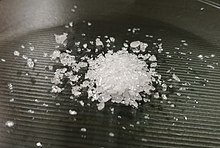
| |||
| |||
| Names | |||
|---|---|---|---|
| Preferred IUPAC name
Antimony trichloride | |||
| Systematic IUPAC name
Trichlorostibane | |||
| Other names
Antimony(III) chloride, Butter of antimony, Antimonous chloride, Stibous chloride, Trichlorostibine
| |||
| Identifiers | |||
3D model (JSmol)
|
|||
| ChEBI | |||
| ChemSpider | |||
| ECHA InfoCard | 100.030.031 | ||
| EC Number |
| ||
| KEGG | |||
| MeSH | Antimony+trichloride | ||
PubChem CID
|
|||
| RTECS number |
| ||
| UNII | |||
| UN number | 1733 | ||
CompTox Dashboard (EPA)
|
|||
| |||
| |||
| Properties | |||
| Cl3Sb | |||
| Molar mass | 228.11 g·mol−1 | ||
| Appearance | Colorless solid, very hygroscopic | ||
| Odor | Sharp, pungent | ||
| Density | 3.14 g/cm3 (25 °C) 2.51 g/cm3 (150 °C)[1] | ||
| Melting point | 73.4 °C (164.1 °F; 346.5 K)[5] | ||
| Boiling point | 223.5 °C (434.3 °F; 496.6 K) | ||
| 601.1 g/100 ml (0 °C)[1] 985.1 g/100 mL (25 °C) 1.357 kg/100 mL (40 °C)[2] | |||
| Solubility | Soluble in acetone, ethanol, CH2Cl2, phenyls, ether, dioxane, CS2, CCl4, CHCl3, cyclohexane, selenium(IV) oxychloride Insoluble in pyridine, quinoline, organic bases | ||
| Solubility in acetic acid | 143.9 g/100 g (0 °C) 205.8 g/100 g (10 °C) 440.5 g/100 g (25 °C)[3] 693.7 g/100 g (45 °C)[2] | ||
| Solubility in acetone | 537.6 g/100 g (18 °C)[2][3] | ||
| Solubility in benzoyl chloride | 139.2 g/100 g (15 °C) 169.5 g/100 g (25 °C)[3] 2.76 kg/100 g (70 °C)[2] | ||
| Solubility in hydrochloric acid | 20 °C: 8.954 g/ g (4.63% w/w) 8.576 g/ g (14.4% w/w) 7.898 g/ g (36.7% w/w)[2] | ||
| Solubility in p-Cymene | 69.5 g/100 g (-3.5 °C) 85.5 g/100 g (10 °C) 150 g/100 g (30 °C) 2.17 kg/100 g (70 °C)[2] | ||
| Vapor pressure | 13.33 Pa (18.1 °C)[3] 0.15 kPa (50 °C) 2.6 kPa (100 °C)[4] | ||
| -86.7·10−6 cm3/mol | |||
Refractive index (nD)
|
1.46[1] | ||
| Structure | |||
| Orthorhombic | |||
| 3.93 D (20 °C)[3] | |||
| Thermochemistry | |||
Heat capacity (C)
|
183.3 J/mol·K[3] | ||
Std molar
entropy (S⦵298) |
110.5 J/mol·K[3] | ||
Std enthalpy of
formation (ΔfH⦵298) |
-381.2 kJ/mol[3] | ||
Gibbs free energy (ΔfG⦵)
|
-322.5 kJ/mol[3] | ||
| Hazards | |||
| GHS labelling: | |||
  [5] [5]
| |||
| Danger | |||
| H314, H411[5] | |||
| P273, P280, P305+P351+P338, P310[5] | |||
| NFPA 704 (fire diamond) | |||
| Flash point | Non-flammable | ||
| Lethal dose or concentration (LD, LC): | |||
LD50 (median dose)
|
525 mg/kg (oral, rat) | ||
| NIOSH (US health exposure limits): | |||
PEL (Permissible)
|
TWA 0.5 mg/m3 (as Sb)[6] | ||
REL (Recommended)
|
TWA 0.5 mg/m3 (as Sb)[6] | ||
| Safety data sheet (SDS) | ICSC 1224 | ||
| Related compounds | |||
Other anions
|
Antimony trifluoride Antimony tribromide Antimony triiodide | ||
Other cations
|
Nitrogen trichloride Phosphorus trichloride Arsenic trichloride Bismuth chloride | ||
Related compounds
|
Antimony pentachloride | ||
Except where otherwise noted, data are given for materials in their standard state (at 25 °C [77 °F], 100 kPa).
| |||
Antimony trichloride is the chemical compound with the formula SbCl3. It is a soft colorless solid with a pungent odor and was known to alchemists as butter of antimony.
- ^ a b c "Antimony Trichloride, SbCl3".
- ^ a b c d e f Seidell, Atherton; Linke, William F. (1952). Solubilities of Inorganic and Organic Compounds. Van Nostrand.
- ^ a b c d e f g h i "Antimony(III) chloride".
- ^ Antimony trichloride in Linstrom, Peter J.; Mallard, William G. (eds.); NIST Chemistry WebBook, NIST Standard Reference Database Number 69, National Institute of Standards and Technology, Gaithersburg (MD) (retrieved 2014-05-28)
- ^ a b c d Sigma-Aldrich Co., Antimony(III) chloride. Retrieved on 2014-05-29.
- ^ a b NIOSH Pocket Guide to Chemical Hazards. "#0036". National Institute for Occupational Safety and Health (NIOSH).


